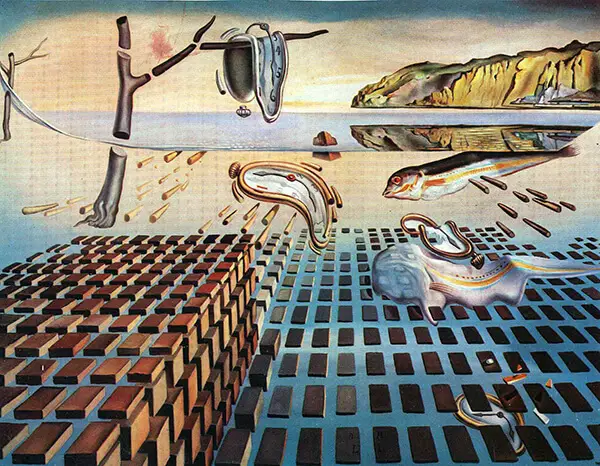Originally featured in the Carstairs Gallery in New York, the painting can now be found in the Salvador Dali Museum in St. Petersburg, Florida, which holds the largest collection of his work outside of Europe.
As one of surrealism's most famous figures, Salvador Dali not only painted but also did sculpture, film, and photography.
As an iconic figure and cultural icon known for his eccentricities, recognizable mustache and his work in various mediums and industries, Salvador Dali and his influence is still felt today.
Born in Figueres, Spain, Dali moved to Madrid for his studies. He even got to meet Picasso on one of his numerous visits to Paris, where he later lived and met his wife, Gala. Despite being expelled from school, Dali had already created a name for himself and established his characteristic and recognizable style.
In 1934, Dali made his first trip to the United States by visiting New York where some of his works were exhibited and well-received, including his most famous painting, Persistence of Memory (1931).
Dali and Gala moved to America as World War II took over Europe. While living here, Dali tried his hand in fashion and furniture design as well as theatre and film set decoration.
In 1948, Dali and Gala moved back to Spain and Dali would continue paint and get involved in various other projects for the rest of his life. Somewhat poetically, Dali passed away in his birthplace, Figueres, in 1989.
The surrealist movement of which Dali was a huge part began in the early 1920s.
The art during this time commonly depicted the creation of strange creatures and scenes that usually did not make sense and were disturbing. The movement was meant to show the expression of the unconscious, reveal philosophical ideas of the time and reflect the alienation felt by society.
Although beginning as an art movement, surrealism became an actual social revolution. The artists and thinkers of the time wanted the public to have more free thought and to realize there is a whole world related to the mind.
They also wanted more freedom in general from societal structures. It was often associated with communism, although not all surrealist artists or writers necessarily supported communist governments.
The movement continued throughout the 1930s and 1940s despite World War II. Some artists today still make paintings of a surrealist nature, so it has stood the test of time.
The painting The Disintegration of the Persistence of Memory is a response to another painting of Dali's called Persistence of Memory (1931). Both paintings have similar main features but the second painting shows the original in a state of disintegration, as stated in the title.
Painted over 20 years apart, the second painting clearly reflects a different society and a different mind-frame of Dali.
The original painting is seen as representing time as fluid rather than rigid through the melting watches, a characteristic symbol of Dali's.
In the new painting, the watches are featured again but the significance of the painting has changed drastically. The original landscape has become flooded and although it seems relatively calm above the surface, there is a lot of activity going on below.
The activity going on below the surface is a reflection of some of the new ideas Dali learned throughout the surrealism movement as well as changes to society as a result of global war.
The bricks along the bottom are said to represent atoms, which is something new that was learned by Dali and all of society through the study and quantum mechanics. The other elements, like the olive tree breaking apart and the cylindrical shapes are related and more bleak.
The olive tree is a symbol of peace, which is evidently being broken in relation to the shapes which represent atomic missiles.
At the time of this painting, the Cold War would have been going on, which is known for the fear of atomic bombs possibly causing the end of the world or the destruction of society.
The painting also features the melting clocks, as mentioned above. Overall, this painting is understood as showing Dali's loss of interest in surrealism because it is the breaking down of his most famous work, Persistence of Memory, created at the height of the movement.
Despite Dali's breaking away from surrealism with this painting, he will forever be associated with it due to his striking and iconic paintings.

